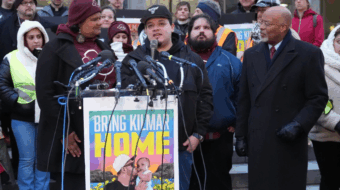
For asylum seekers and refugees forced to stay in Mexico as their requests to enter the United States enter procedural limbo, their lives are minimized to being political and legal ping-pong balls, going back and forth over the new (incomplete) border wall with every court ruling or Trump administration executive order.
On Monday, Oct. 19, the U.S. Supreme Court agreed to review the Trump administration’s “Remain in Mexico” policy, officially known as the “Migrant Protection Protocols,” which forces migrants to return to Mexico as they await their U.S. immigration Court hearings. Typical of the high court, with its calendar already full through the end of the year, there was no announcement it would hear the case, just an order list notation. The case will not be heard until 2021.
The Trump administration had petitioned the high court to intervene because of decisions against it in lower courts.
If Joe Biden wins the presidential election and voids Donald Trump’s policy, the case would become mostly moot, as the new administration would likely implement new policy procedures regarding asylum seekers at the U.S.’ southern border.
Introduced in January 2019, Trump’s policy became a key mainstay of the administration’s dreadful response to the unparalleled surge of asylum seeking families arriving at the border, drawing heavy criticism for having families wait in inhumane housing conditions in dangerous Mexican cities.
“In the last few months, migrants and asylum seekers have been telling us about the horrendous conditions in detention—being denied medication, food, and water, people getting sick, mistreated, psychologically abused…they were talking about a detention nightmare,” said Fernando Garcia, founder and executive director of the Border Network for Human Rights in July 2019.
“Just this past week we have had at least four refugees killed in Juárez. We also just learned that a refugee family we helped from Honduras, a mother precisely, survived a kidnapping attempt of her and her children—they are being sent to experience a different nightmare,” he continued.
As of today, there are a total of 1,246,164 pending U.S. immigration court cases for asylum seekers, refugees, and migrants—an increase of over 200,000 compared to 2019.
Since implementation, the policy has faced legal and public challenges to its indecency and inconsistency with “American values.”
The U.S. Court of Appeals for the 9th Circuit blocked the Trump administration’s policy in two states, Arizona and California, in March 2020 and upheld a lower court’s ruling that the policy violates the law. However, there was a bit of confusion on the part of judges who were uncertain about the scope of their injunction since the legal question surrounding the policy was “a matter of intense and active controversy.”
Notable in the written ruling was the number of statements from anonymous asylum seekers detailing their ordeals and fears of returning to Mexico.
People’s World Election Town Hall – Oct. 25th – Register here.
“Several declarants described violence and threats of violence in Mexico. Much of the violence was directed at the declarants because they were non-Mexican—that is, because of their nationality, a protected ground under asylum law,” the appellate court wrote.
The court also highlighted that when asylum seekers were interviewed by the Department of Homeland Security officers, not once did officials ask whether they feared returning to Mexico.
Gregory Doe wrote, “The officer never asked me if I was afraid of being in Mexico or if anything bad had happened to me here [in Mexico].”
The 9th Circuit Court of Appeals’ block of the Trump administration’s policy was brief, as the administration immediately appealed to the U.S. Supreme Court, which then allowed the controversial policy to continue as the case continued with its legal appeals.
Over 60,000 asylum seekers were returned to Mexico under the policy, and the Department of Justice estimated in late February of this year that there were 25,000 people still waiting in Mexico for a U.S. court hearing.
All hearings were suspended following the coronavirus pandemic.
“It has been over a year since a federal district court struck down the administration’s illegal policy of forcing asylum seekers to wait in Mexico,” said CGRS Legal Director Blaine Bookey.
“Yet thousands of families remain stranded in increasingly perilous conditions, where many have faced brutal violence and homelessness. We will continue the fight to stop this cruelty once and for all.”
People’s World correspondent Al Neal spent the summer of 2019 in the field reporting from sites all along the U.S.-Mexico border, writing about and photographing the conditions of migrants, refugees, and asylum-seekers. In his dispatches, you get a view of the towns and people caught up in Trump’s “border crisis.”











